
generative-ai-application-builder-on-aws
Generative AI Application Builder on AWS facilitates the development, rapid experimentation, and deployment of generative artificial intelligence (AI) applications without requiring deep experience in AI. The solution includes integrations with Amazon Bedrock and its included LLMs, such as Amazon Titan, and pre-built connectors for 3rd-party LLMs.
Stars: 143
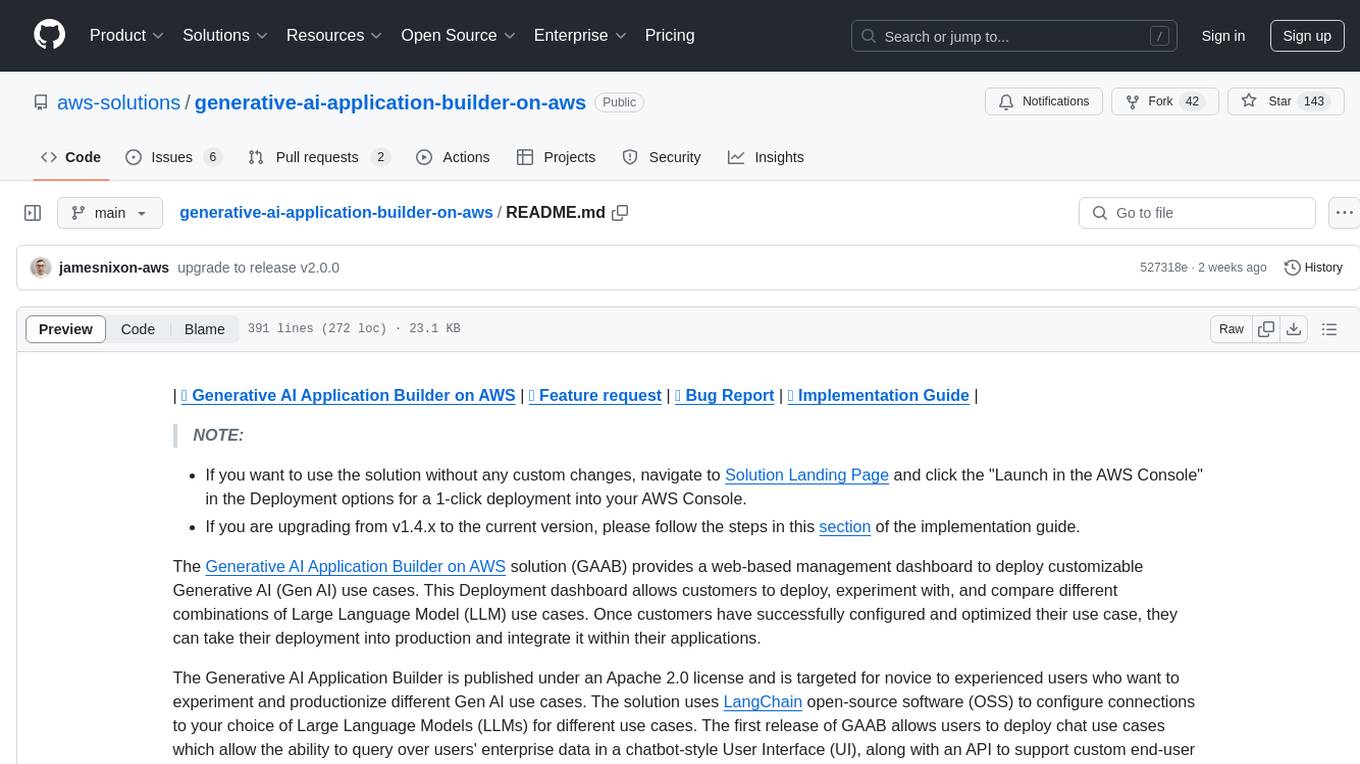
The Generative AI Application Builder on AWS (GAAB) is a solution that provides a web-based management dashboard for deploying customizable Generative AI (Gen AI) use cases. Users can experiment with and compare different combinations of Large Language Model (LLM) use cases, configure and optimize their use cases, and integrate them into their applications for production. The solution is targeted at novice to experienced users who want to experiment and productionize different Gen AI use cases. It uses LangChain open-source software to configure connections to Large Language Models (LLMs) for various use cases, with the ability to deploy chat use cases that allow querying over users' enterprise data in a chatbot-style User Interface (UI) and support custom end-user implementations through an API.
README:
| ✨ Generative AI Application Builder on AWS | 🚧 Feature request | 🐛 Bug Report | 📖 Implementation Guide |
NOTE:
- If you want to use the solution without any custom changes, navigate to Solution Landing Page and click the "Launch in the AWS Console" in the Deployment options for a 1-click deployment into your AWS Console.
- If you are upgrading from v1.4.x to the current version, please follow the steps in this section of the implementation guide.
The Generative AI Application Builder on AWS solution (GAAB) provides a web-based management dashboard to deploy customizable Generative AI (Gen AI) use cases. This Deployment dashboard allows customers to deploy, experiment with, and compare different combinations of Large Language Model (LLM) use cases. Once customers have successfully configured and optimized their use case, they can take their deployment into production and integrate it within their applications.
The Generative AI Application Builder is published under an Apache 2.0 license and is targeted for novice to experienced users who want to experiment and productionize different Gen AI use cases. The solution uses LangChain open-source software (OSS) to configure connections to your choice of Large Language Models (LLMs) for different use cases. The first release of GAAB allows users to deploy chat use cases which allow the ability to query over users' enterprise data in a chatbot-style User Interface (UI), along with an API to support custom end-user implementations.
Some of the features of GAAB are:
- Rapid experimentation with ability to productionize at scale
- Extendable and modularized architecture using nested Amazon CloudFormation stacks
- Enterprise ready for company-specific data to tackle real-world business problems
- Integration with Amazon Bedrock and Amazon SageMaker as LLM providers
- Multi-LLM comparison and experimentation with metric tracking using Amazon CloudWatch dashboards
- Growing list of model providers and Gen AI use cases
For a detailed solution implementation guide, refer to The Generative AI Application Builder on AWS
- Architecture Overview
- Deployment
- Source code
- SageMaker Model Input Documentation
- Creating a custom build
There are 3 unique user personas that are referred to in the solution walkthrough below:
- The DevOps user is responsible for deploying the solution within the AWS account and for managing the infrastructure, updating the solution, monitoring performance, and maintaining the overall health and lifecycle of the solution.
- The admin users are responsible for managing the content contained within the deployment. These users gets access to the Deployment dashboard UI and is primarily responsible for curating the business user experience. This is our primary target customer.
- The business users represents the individuals who the use case has been deployed for. They are the consumers of the knowledge base and the customer responsible for evaluating and experimenting with the LLMs.
NOTE:
- You have the option of deploying the solution as a VPC enabled configuration. With a VPC enabled configuration, you can choose
- if the solution should build the VPC for this deployment.
- if you would like to deploy the solution in a VPC existing in your AWS account.
- To see the VPC related architecture diagrams, please visit the implementation guide.
When the DevOps user deploys the Deployment Dashboard, the following components are deployed in the AWS account:
- The admin users can log in to the deployed Deployment Dashboard UI.
- Amazon CloudFront delivers the web UI which is hosted in an Amazon S3 bucket.
- AWS WAF protects the APIs from attacks. This solution configures a set of rules called a web access control list (web ACL) that allows, blocks, or counts web requests based on configurable, user-defined web security rules and conditions.
- The web UI leverages a set of REST APIs that are exposed using Amazon API Gateway.
- Amazon Cognito authenticates users and backs both the Cloudfront web UI and API Gateway. An Amazon DynamoDB table is used to store the AWS IAM policy of authorized users.
- AWS Lambda is used to provide the business logic for the REST endpoints. This Backing Lambda will manage and create the necessary resources to perform use case deployments using AWS Cloudformation.
- Amazon DynamoDB is used to store the list of deployments.
- When a new use case is created by the admin user, the Backing Lambda will initiate a CloudFormation stack creation event for the requested use case.
- All of the LLM configuration options provided by the admin user in the deployment wizard are saved in DynamoDB. The deployment uses this DynamoDB table to configure the LLM at runtime.
- Using Amazon Cloudwatch, this solution collects operational metrics from various services to generate custom dashboards that allow you to monitor the solution's performance and operational health.
Note: Although the Deployment dashboard can be launched in most AWS regions, the deployed use cases have some restrictions based on service availability. See Supported AWS Regions in the Implementation Guide for more details.
Once the Deployment Dashboard is deployed, the admin user can then deploy multiple use case stacks. When a use case stack is deployed by the admin user, the following components are deployed in the AWS account:
- Admin users deploy the use case using the Deployment dashboard. Business users log in to the use case UI.
- Amazon CloudFront delivers the web UI which is hosted in an Amazon S3 bucket.
- The web UI leverages a WebSocket integration built using Amazon API Gateway. The API Gateway is backed by a custom Lambda Authorizer function, which returns the appropriate AWS IAM policy based on the Amazon Cognito group the authenticating user is part of. The policy is stored in Amazon DynamoDB.
- Amazon Cognito authenticates users and backs both the Cloudfront web UI and API Gateway.
- Incoming requests from the business user are passed from API Gateway to an Amazon SQS queue and then to the LangChain Orchestrator. The LangChain Orchestrator is a collection of Lambda functions and layers that provide the business logic for fulfilling requests coming from the business user. The queue enables the asynchronous operation of the API Gateway to Lambda integration. The queue passes connection information to the Lambda functions which will then post results directly back to the API Gateway websocket connection to support long running inference calls.
- The LangChain Orchestrator uses Amazon DynamoDB to get the configured LLM options and necessary session information (such as the chat history).
- If the deployment has a knowledge base configured, then the LangChain Orchestrator leverages Amazon Kendra or Knowledge Bases for Amazon Bedrock to run a search query to retrieve document excerpts.
- Using the chat history, query, and context from the knowledge base, the LangChain Orchestrator creates the final prompt and sends the request to the LLM hosted on Amazon Bedrock or Amazon SageMaker.
- When the response comes back from the LLM, the LangChain Orchestrator streams the response back through the API Gateway WebSocket to be consumed by the client application.
- Using Amazon CloudWatch, this solution collects operational metrics from various services to generate custom dashboards that allow you to monitor the deployment’s performance and operational health.
NOTE:
- To use Amazon Bedrock, you must request access to models before they are available for use. Refer to Model access in the Amazon Bedrock User Guide for more details.
- You can also test the UI project locally by deploying the API endpoints and the rest of the infrastructure. To do so, follow either of the below two options and then refer Deployment Dashboard and Chat UI project for details.
There are two options for deployment into your AWS account:
Following are pre-requisites to build and deploy locally:
- Docker
- Nodejs 20.x
- CDK v2.118.0
-
Python >= 3.11, <=3.12.1
- Note: normal python installations should include support for
ensurepipandpip; however, if running in an environment without these packages you will need to manually install them (e.g. a minimal docker image). See pip's installation guide for details.
- Note: normal python installations should include support for
- AWS CLI
- jq
Note: Configure the AWS CLI with your AWS credentials or have them exported in the CLI terminal environment. In case the credentials are invalid or expired, running cdk deploy produces an error.
Also, if you have not run cdk bootstrap in this account and region, please follow the instructions here to execute cdk bootstrap as a one time process before proceeding with the below steps.
After cloning the repo from GitHub, complete the following steps:
NOTE:
- Please update the
cdk-asset-bucketproperty insource/infrastructure/cdk.json. The value of this property should be the bucket name thatcdk bootstrapprocess created. Unless a bucket name is configured, thecdk bootstrapprocess creates a bucket in the following format:cdk-hnb659fds-assets-<aws-account-number>-<region>(where is the AWS Account ID where the solution is being deployed in the specific ). The repo currently has the value set as the following:
If deployed with this default value, the use case creation from deployment dashboards would fail."cdk-asset-bucket": "cdk-hnb659fds-assets-123456789012-us-east-1"
cd <project-directory>/source/infrastructure
npm install
npm run build
cdk synth
cdk deploy DeploymentPlatformStack --parameters AdminUserEmail=<replace with admin user's email>
Note: Because cdk deploy is executed with a stack name, it does not synthesize the other CloudFormation stacks in the infrastructure folder. To ensure all stacks are synthesized based on the infrastructure code changes, please ensure to cdk synth. For a complete list of cdk commands that can be run, see Toolkit commands
For the deployment dashboard to deploy LLM chat use cases, you would additionally need to stage synthesized CDK assets (such as lambdas, synthesized CloudFormation templates, etc.) from the source/infrastructure/cdk.out directory to a configured S3 bucket in your account from where these resources will be pulled from at the time of deployment. To make it easy to stage these assets, you can use the source/stage-assets.sh script. This script should be run from the source directory.
cd <project-directory>/source
./stage-assets.sh
When run, the script looks like this:
>>> ./stage-assets.sh
This script should be run from the 'source' folder
The region to upload CDK artifacts to (default:us-east-1)?
>>> us-west-2
>>> All assets will be uploaded to cdk-hnb659fds-assets-123456789-us-west-2
>>> Do you want to proceed? (y/n) y
You must provide the full region name as the first input to the script as shown in the above example.
Note: Assets must be staged every time there is a change in the codebase to have the most up-to-date staged assets. It is also recommend to run cdk synth before staging.
Refer section Creating a custom build
├── CHANGELOG.md
├── CODE_OF_CONDUCT.md
├── CONTRIBUTING.md
├── Config
├── LICENSE.txt
├── NOTICE.txt
├── README.md
├── buildspec.yml
├── deployment
│ ├── build-open-source-dist.sh
│ ├── build-s3-dist.sh
│ ├── cdk-solution-helper
│ ├── clean-for-scan.sh
│ ├── get-cdk-version.js
│ └── manifest.yaml
| ├── run-unit-tests.sh [shell script that can run unit tests for the entire project]
├── pyproject.toml
├── pytest.ini
├── sonar-project.properties
└── source
├── images
├── infrastructure [CDK infrastructure]
├── lambda [Lambda functions for the application]
├── pre-build-lambda-layers.sh [pre-builds lambda layers for the project]
├── scripts [standalone utility scripts]
├── stage-assets.sh
├── test
├── ui-chat [Web App project for chat UI]
└── ui-deployment [Web App project for deployment dashboard UI]
└── docs
The project provides a docs folder which gives you access to sample SageMaker inputs. As SageMaker models can take in and output a variety of input and output schemas, respectively, the solution requests these values from the users to allow correct model invocation. This allows the solution to support a wide set of SageMaker models.
The input schemas are essentially your model's payload, with placeholders for the actual values. The placeholders enable replacing the actual model values at run-time and are represented by a keyword enclosed in angle brackets like: <<prompt>>. Note that <<prompt>> and <<temperature>> are reserved placeholders for the model prompt and temperatures respectively.
The model's output JSONPath provides the solution a path to retrieve the LLM's textual response from the model response.
Please always refer to model documentation and SageMaker JumpStart jupyter notebook samples to see the most up-to-date model payloads and supported parameters.
Run the following command:
git clone https://github.com/aws-solutions/<repository_name>
- Install the dependencies:
cd <rootDir>/source/infrastructure
npm install
- (Optional) Run the unit tests:
Note: To run the unit tests, docker must be installed and running, and valid AWS credentials must be configured.
cd <rootDir>/deployment
chmod +x ./run-unit-tests.sh
./run-unit-tests.sh
- Configure the bucket name of your target Amazon S3 distribution bucket:
export DIST_OUTPUT_BUCKET=my-bucket-name
export VERSION=my-version
- Build the distributable:
cd <rootDir>/deployment
chmod +x ./build-s3-dist.sh
./build-s3-dist.sh $DIST_OUTPUT_BUCKET $SOLUTION_NAME $VERSION $CF_TEMPLATE_BUCKET_NAME
Parameter details:
$DIST_OUTPUT_BUCKET - This is the global name of the distribution. For the bucket name, the AWS Region is added to the global name (example: 'my-bucket-name-us-east-1') to create a regional bucket. The lambda
artifacts should be uploaded to the regional buckets for the CloudFormation template to pick it up for deployment.
$SOLUTION_NAME - The name of This solution (example: generative-ai-application-builder-on-aws)
$VERSION - The version number of the change
$CF_TEMPLATE_BUCKET_NAME - The name of the S3 bucket where the CloudFormation templates should be uploaded
When you create and use buckets, we recommended that you:
- Use randomized names or uuid as part of your bucket naming strategy.
- Ensure that buckets aren't public.
- Verify bucket ownership prior to uploading templates or code artifacts.
- Deploy the distributable to an Amazon S3 bucket in your account.
Note: You must have the AWS CLI installed.
aws s3 cp ./global-s3-assets/ s3://my-bucket-name-<aws_region>/generative-ai-application-builder-on-aws/<my-version>/ --recursive --acl bucket-owner-full-control --profile aws-cred-profile-name
aws s3 cp ./regional-s3-assets/ s3://my-bucket-name-<aws_region>/generative-ai-application-builder-on-aws/<my-version>/ --recursive --acl bucket-owner-full-control --profile aws-cred-profile-name
The solution includes two separate React-based web applications: the Deployment Dashboard UI and the Chat UI. Both user interfaces are built using Vite, a modern and fast build tool for modern web projects.
- Node.js (version 16 or later)
- npm (usually included with Node.js)
-
Open a Terminal
- On Windows, you can use the built-in Command Prompt, PowerShell, or a terminal emulator like Git Bash.
- On macOS or Linux, open the default terminal application.
-
Navigate to the Source Directory
- Change to the
sourcedirectory within the project root:cd <project-directory>/source
- Change to the
-
Fetch and Update Runtime Config
-
Run the provided
setup_local_dev_server.pyscript with the appropriate arguments:python setup_local_dev_server.py --ui-project-type <ui_project_name> --website <website_url>- Replace
<ui_project_name>with eitherui-chatorui-deploymentdepending on which UI project you want to set up. - Replace
<website_url>with the URL of the website where the solution is deployed (e.g.,https://example.com).
- Replace
-
The script will fetch the runtime configuration used to configure AWS Amplify, which the project uses. It will also update the Cognito app client by adding the localhost address to the callbackurls and logouturls list, so it works with the Cognito hosted domain.
-
For example, to update the UI Chat project:
python setup_local_dev_server.py --ui-project-type ui-chat --website https://example.comor
python setup_local_dev_server.py -t ui-chat -w https://example.com -
To update the UI Deployment project:
python setup_local_dev_server.py --ui-project-type ui-deployment --website https://example.comor
python setup_local_dev_server.py -t ui-deployment -w https://example.com
-
-
Navigate to the UI Project Directory
-
Change to the directory of the UI project you want to work with:
cd ui-chator
cd ui-deployment
-
-
Install Dependencies
-
Install the required Node.js dependencies by running the following command in the project directory:
npm install
-
-
Start the Local Development Server
-
In the project directory, run the following command to start the local Vite development server:
npm start -
The Deployment Dashboard UI development server will start at
http://localhost:5177, and the Chat UI development server will start athttp://localhost:5178. -
If these ports are already in use on your machine, you can customize the
setup_local_dev_server.pyscript to use different ports.
-
With the local development environment set up, you can now customize the React components and functionality of the UI projects according to your requirements. The source code for the Deployment Dashboard UI is located in the source/ui-deployment directory, and the source code for the Chat UI is located in the source/ui-chat directory.
Follow the standard React development workflow to make changes to the code, and use the local Vite development server to preview your changes in real-time.
When you're ready to deploy your customized UI projects, follow the instructions in the main README file for building and deploying the solution using the AWS CDK.
This solution collects anonymized operational metrics to help AWS improve the quality and features of the solution. For more information, including how to disable this capability, please see the implementation guide.
Copyright Amazon.com, Inc. or its affiliates. All Rights Reserved.
Licensed under the Apache License, Version 2.0 (the "License"); you may not use this file except in compliance with the License. You may obtain a copy of the License at
http://www.apache.org/licenses/LICENSE-2.0
Unless required by applicable law or agreed to in writing, software distributed under the License is distributed on an "AS IS" BASIS, WITHOUT WARRANTIES OR CONDITIONS OF ANY KIND, either express or implied. See the License for the specific language governing permissions and limitations under the License.
A script is included to migrate use cases created by v1.X to an upgraded v2.X deployment. See the documentation
For Tasks:
Click tags to check more tools for each tasksFor Jobs:
Alternative AI tools for generative-ai-application-builder-on-aws
Similar Open Source Tools

generative-ai-application-builder-on-aws
The Generative AI Application Builder on AWS (GAAB) is a solution that provides a web-based management dashboard for deploying customizable Generative AI (Gen AI) use cases. Users can experiment with and compare different combinations of Large Language Model (LLM) use cases, configure and optimize their use cases, and integrate them into their applications for production. The solution is targeted at novice to experienced users who want to experiment and productionize different Gen AI use cases. It uses LangChain open-source software to configure connections to Large Language Models (LLMs) for various use cases, with the ability to deploy chat use cases that allow querying over users' enterprise data in a chatbot-style User Interface (UI) and support custom end-user implementations through an API.
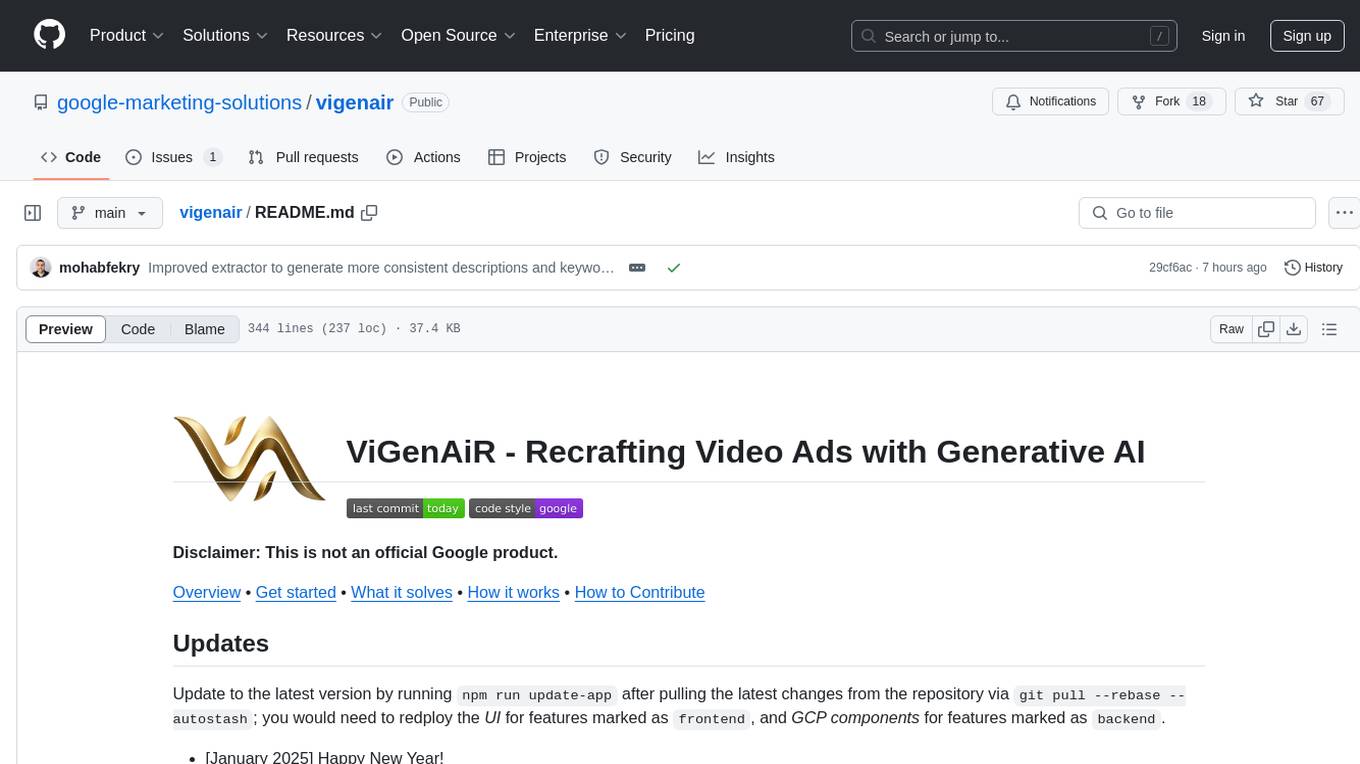
vigenair
ViGenAiR is a tool that harnesses the power of Generative AI models on Google Cloud Platform to automatically transform long-form Video Ads into shorter variants, targeting different audiences. It generates video, image, and text assets for Demand Gen and YouTube video campaigns. Users can steer the model towards generating desired videos, conduct A/B testing, and benefit from various creative features. The tool offers benefits like diverse inventory, compelling video ads, creative excellence, user control, and performance insights. ViGenAiR works by analyzing video content, splitting it into coherent segments, and generating variants following Google's best practices for effective ads.
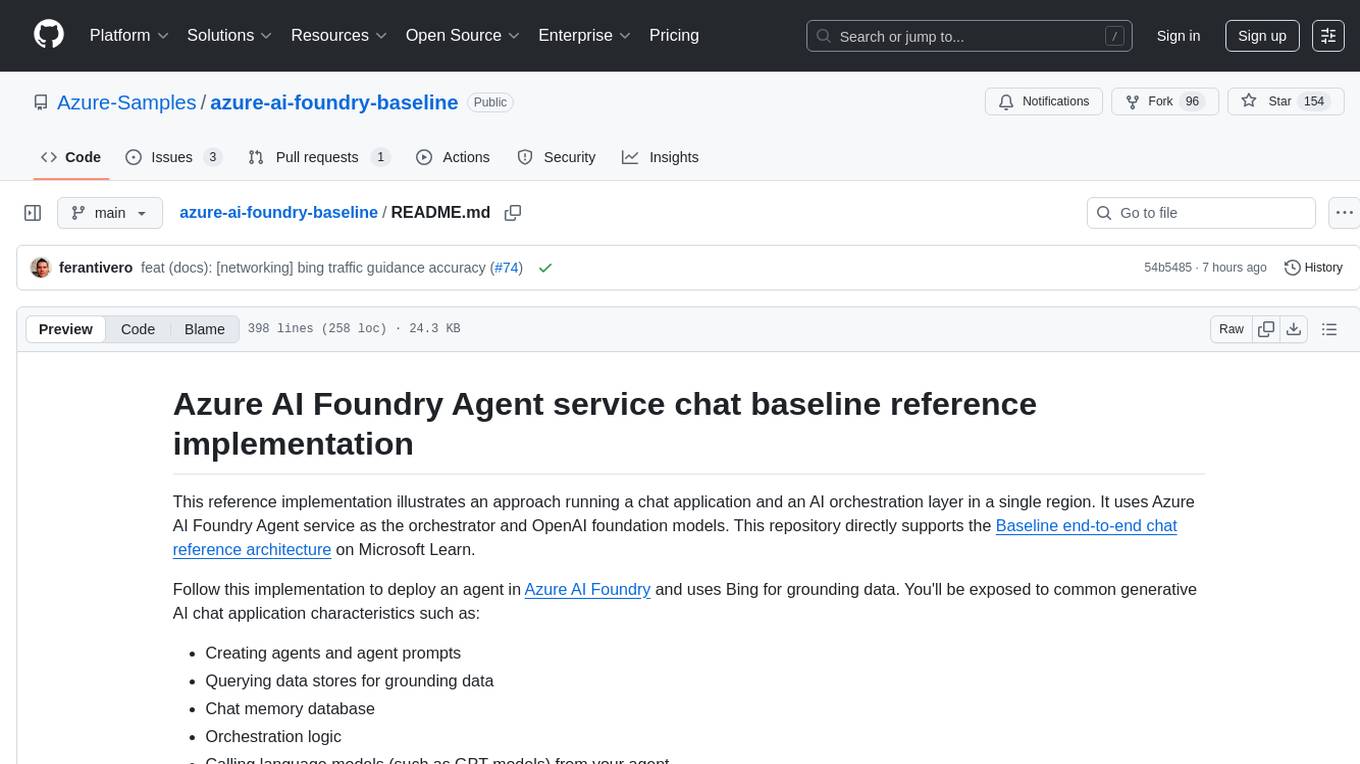
azure-ai-foundry-baseline
This repository serves as a reference implementation for running a chat application and an AI orchestration layer using Azure AI Foundry Agent service and OpenAI foundation models. It covers common generative AI chat application characteristics such as creating agents, querying data stores, chat memory database, orchestration logic, and calling language models. The implementation also includes production requirements like network isolation, Azure AI Foundry Agent Service dependencies, availability zone reliability, and limiting egress network traffic with Azure Firewall.
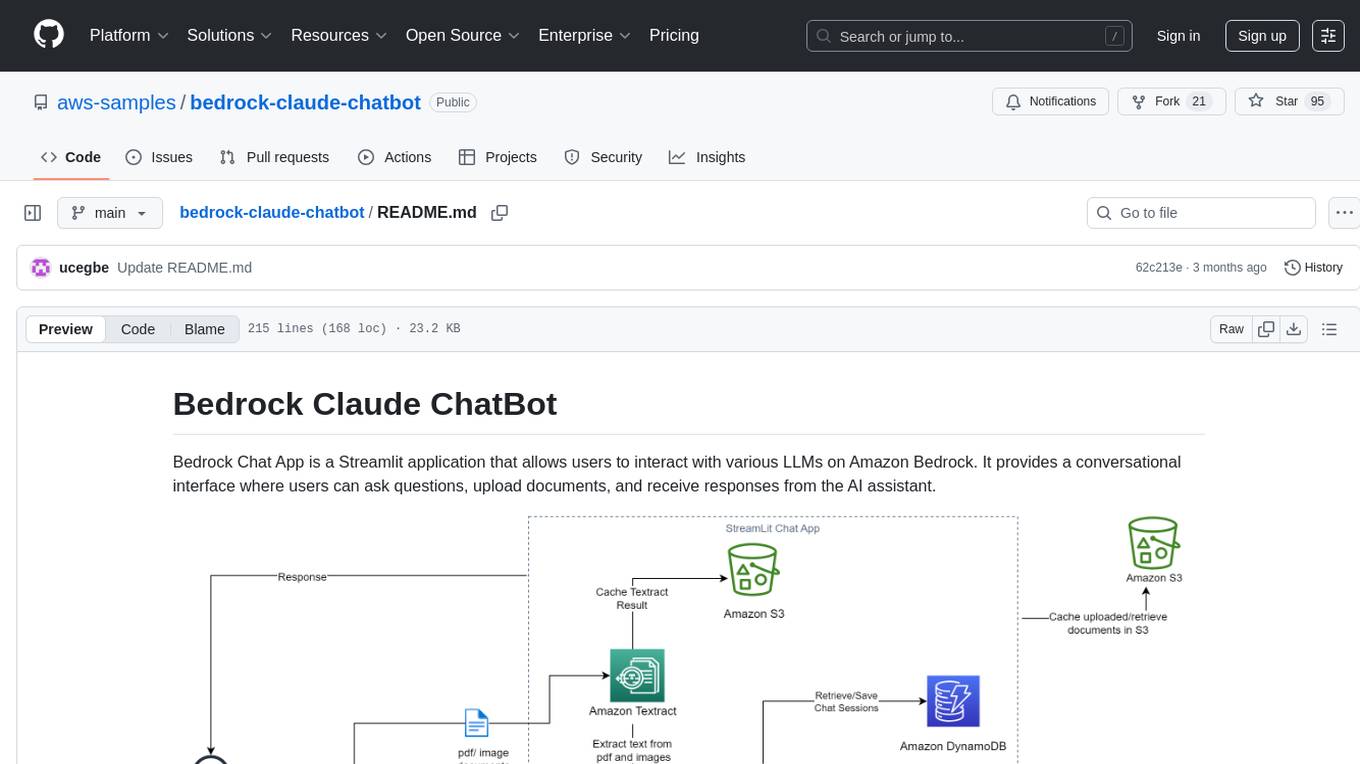
bedrock-claude-chatbot
Bedrock Claude ChatBot is a Streamlit application that provides a conversational interface for users to interact with various Large Language Models (LLMs) on Amazon Bedrock. Users can ask questions, upload documents, and receive responses from the AI assistant. The app features conversational UI, document upload, caching, chat history storage, session management, model selection, cost tracking, logging, and advanced data analytics tool integration. It can be customized using a config file and is extensible for implementing specialized tools using Docker containers and AWS Lambda. The app requires access to Amazon Bedrock Anthropic Claude Model, S3 bucket, Amazon DynamoDB, Amazon Textract, and optionally Amazon Elastic Container Registry and Amazon Athena for advanced analytics features.
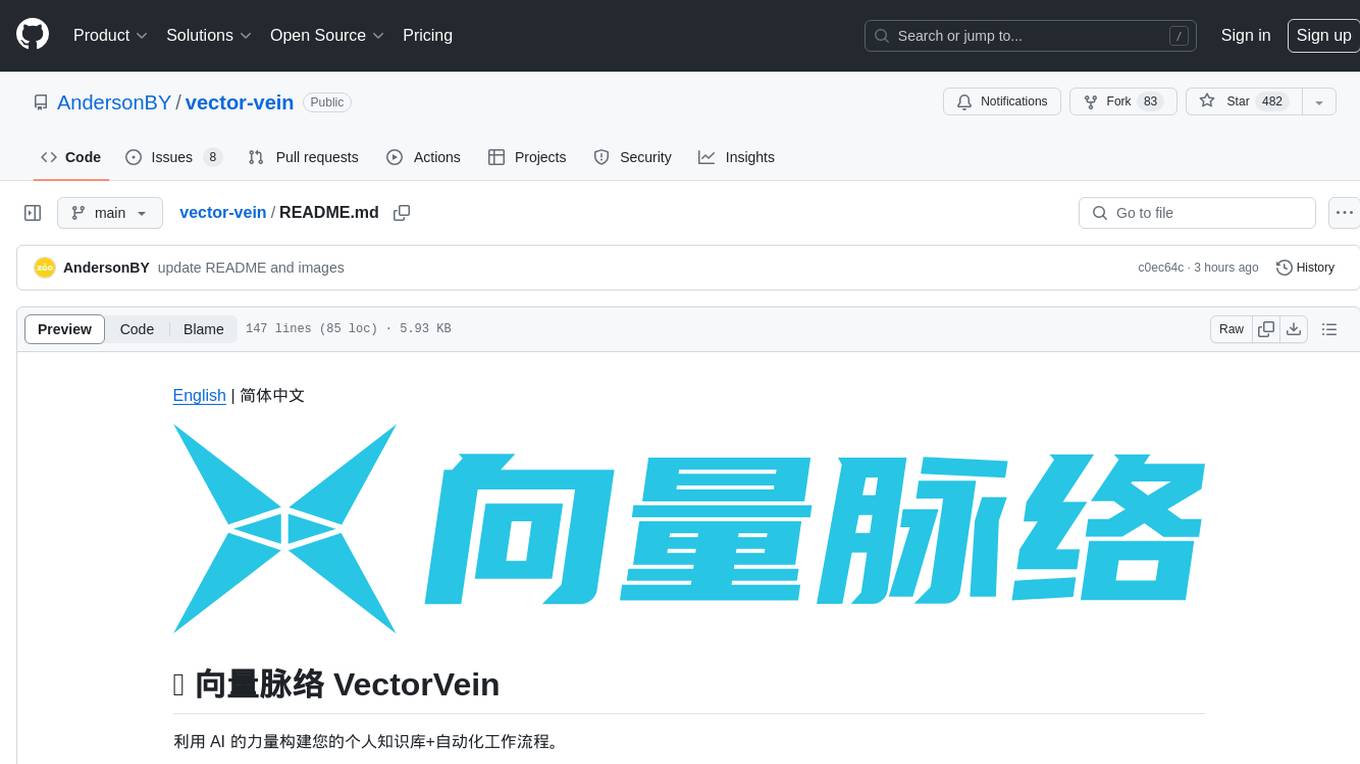
vector-vein
VectorVein is a no-code AI workflow software inspired by LangChain and langflow, aiming to combine the powerful capabilities of large language models and enable users to achieve intelligent and automated daily workflows through simple drag-and-drop actions. Users can create powerful workflows without the need for programming, automating all tasks with ease. The software allows users to define inputs, outputs, and processing methods to create customized workflow processes for various tasks such as translation, mind mapping, summarizing web articles, and automatic categorization of customer reviews.
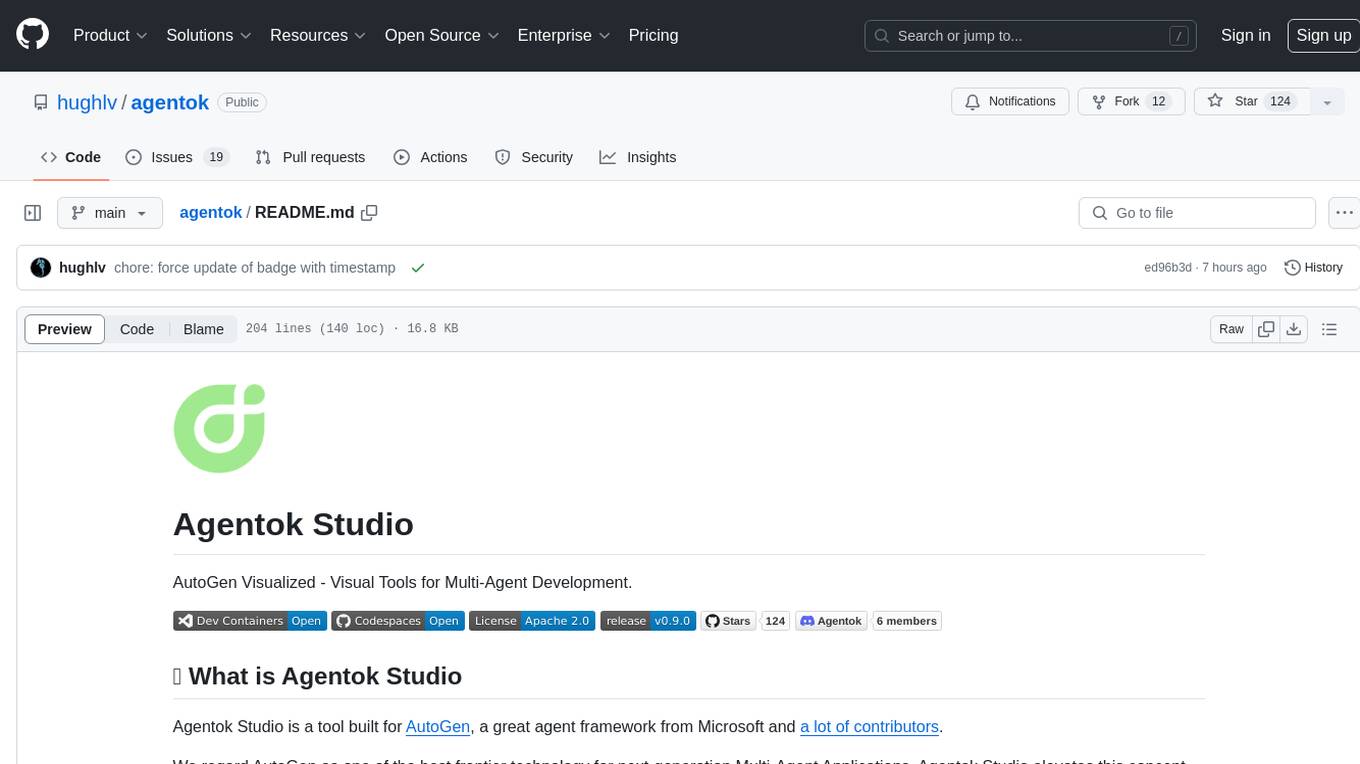
agentok
Agentok Studio is a visual tool built for AutoGen, a cutting-edge agent framework from Microsoft and various contributors. It offers intuitive visual tools to simplify the construction and management of complex agent-based workflows. Users can create workflows visually as graphs, chat with agents, and share flow templates. The tool is designed to streamline the development process for creators and developers working on next-generation Multi-Agent Applications.
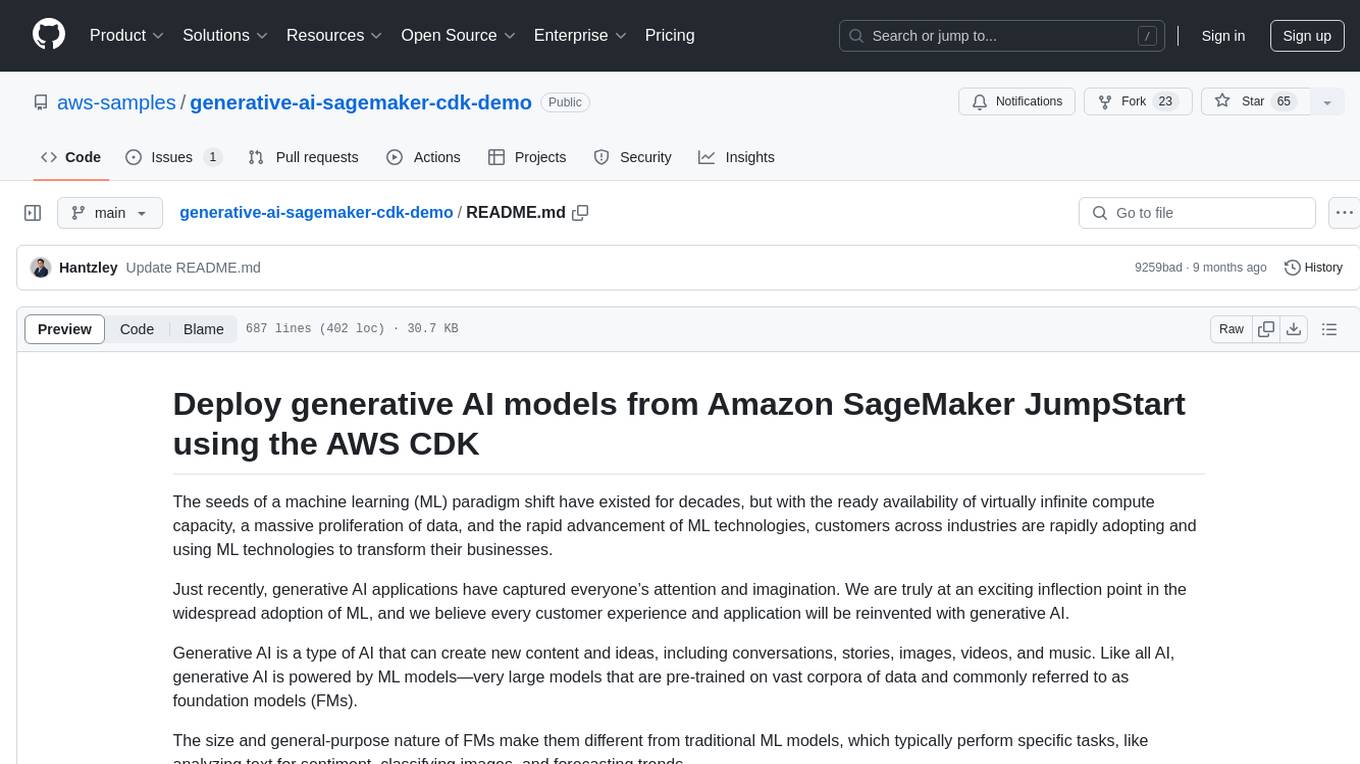
generative-ai-sagemaker-cdk-demo
This repository showcases how to deploy generative AI models from Amazon SageMaker JumpStart using the AWS CDK. Generative AI is a type of AI that can create new content and ideas, such as conversations, stories, images, videos, and music. The repository provides a detailed guide on deploying image and text generative AI models, utilizing pre-trained models from SageMaker JumpStart. The web application is built on Streamlit and hosted on Amazon ECS with Fargate. It interacts with the SageMaker model endpoints through Lambda functions and Amazon API Gateway. The repository also includes instructions on setting up the AWS CDK application, deploying the stacks, using the models, and viewing the deployed resources on the AWS Management Console.
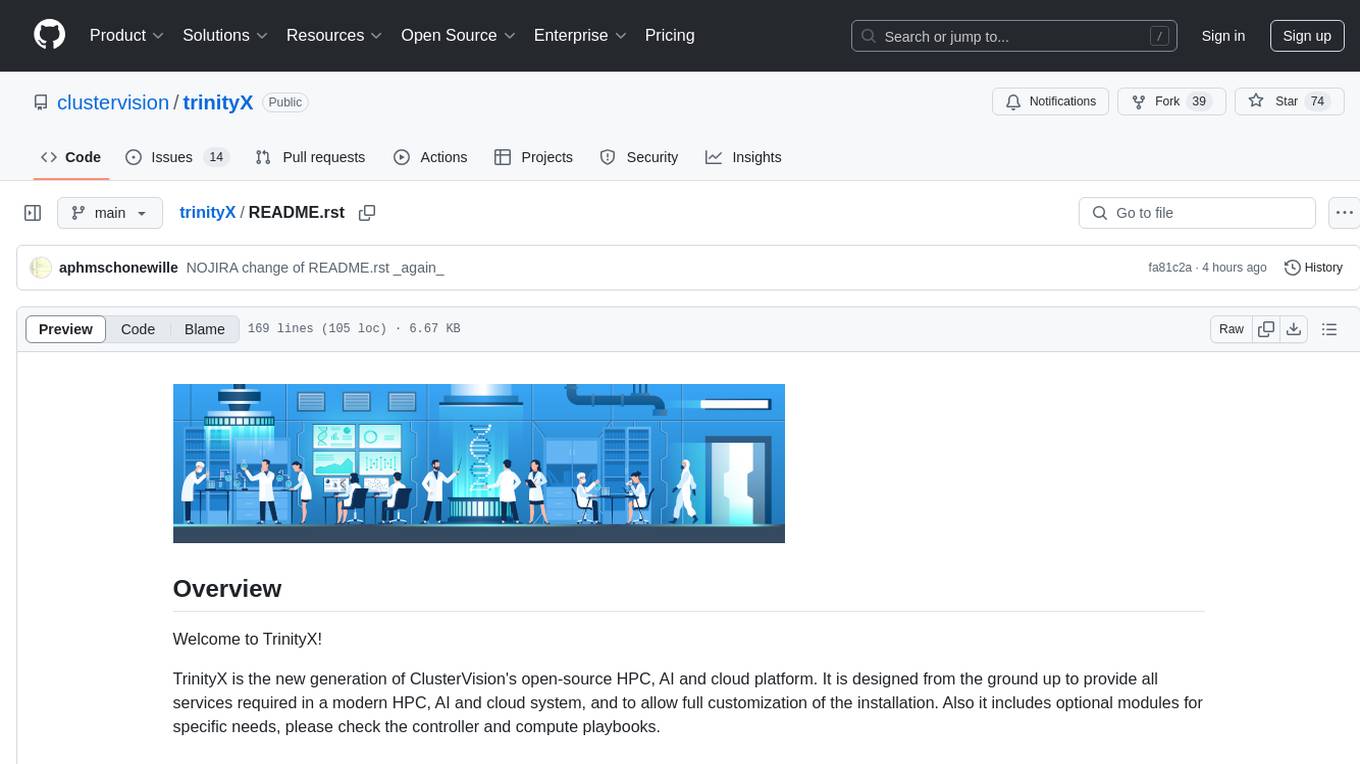
trinityX
TrinityX is an open-source HPC, AI, and cloud platform designed to provide all services required in a modern system, with full customization options. It includes default services like Luna node provisioner, OpenLDAP, SLURM or OpenPBS, Prometheus, Grafana, OpenOndemand, and more. TrinityX also sets up NFS-shared directories, OpenHPC applications, environment modules, HA, and more. Users can install TrinityX on Enterprise Linux, configure network interfaces, set up passwordless authentication, and customize the installation using Ansible playbooks. The platform supports HA, OpenHPC integration, and provides detailed documentation for users to contribute to the project.
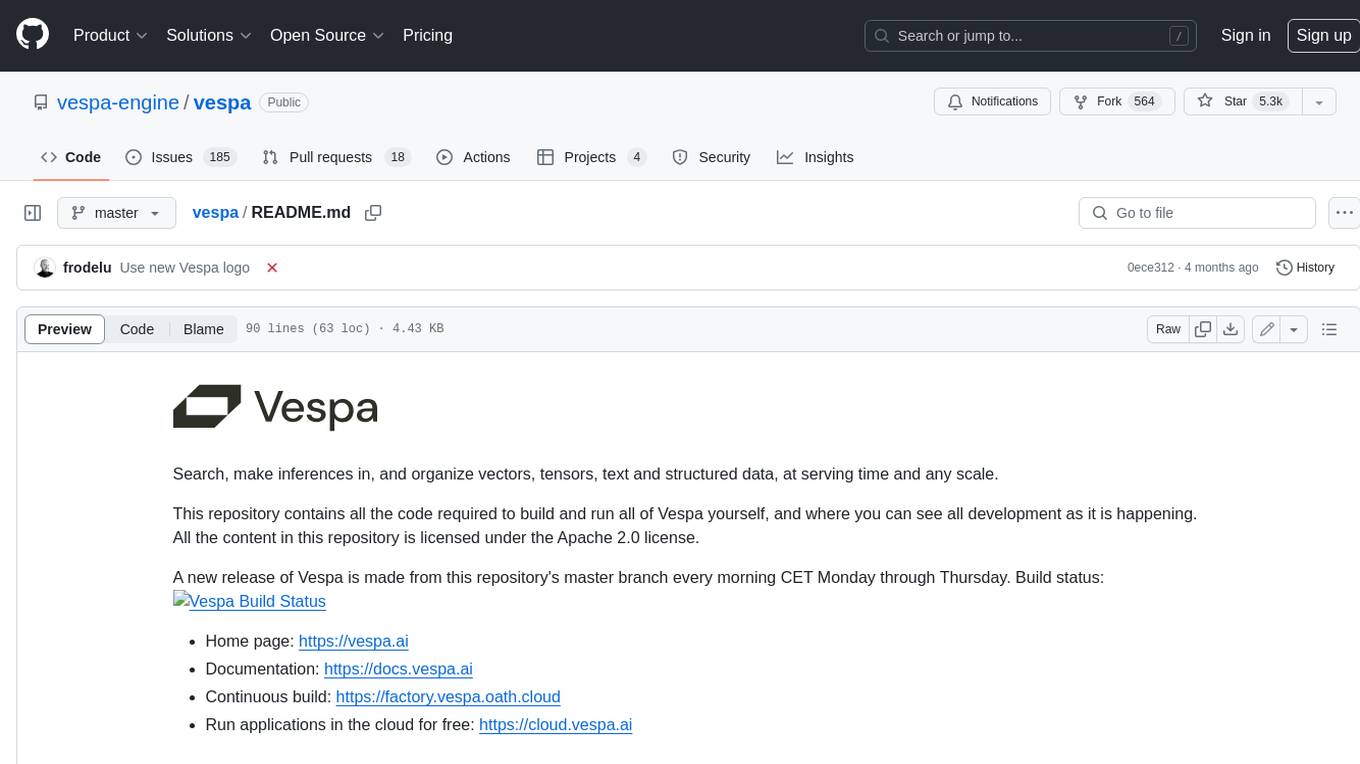
vespa
Vespa is a platform that performs operations such as selecting a subset of data in a large corpus, evaluating machine-learned models over the selected data, organizing and aggregating it, and returning it, typically in less than 100 milliseconds, all while the data corpus is continuously changing. It has been in development for many years and is used on a number of large internet services and apps which serve hundreds of thousands of queries from Vespa per second.
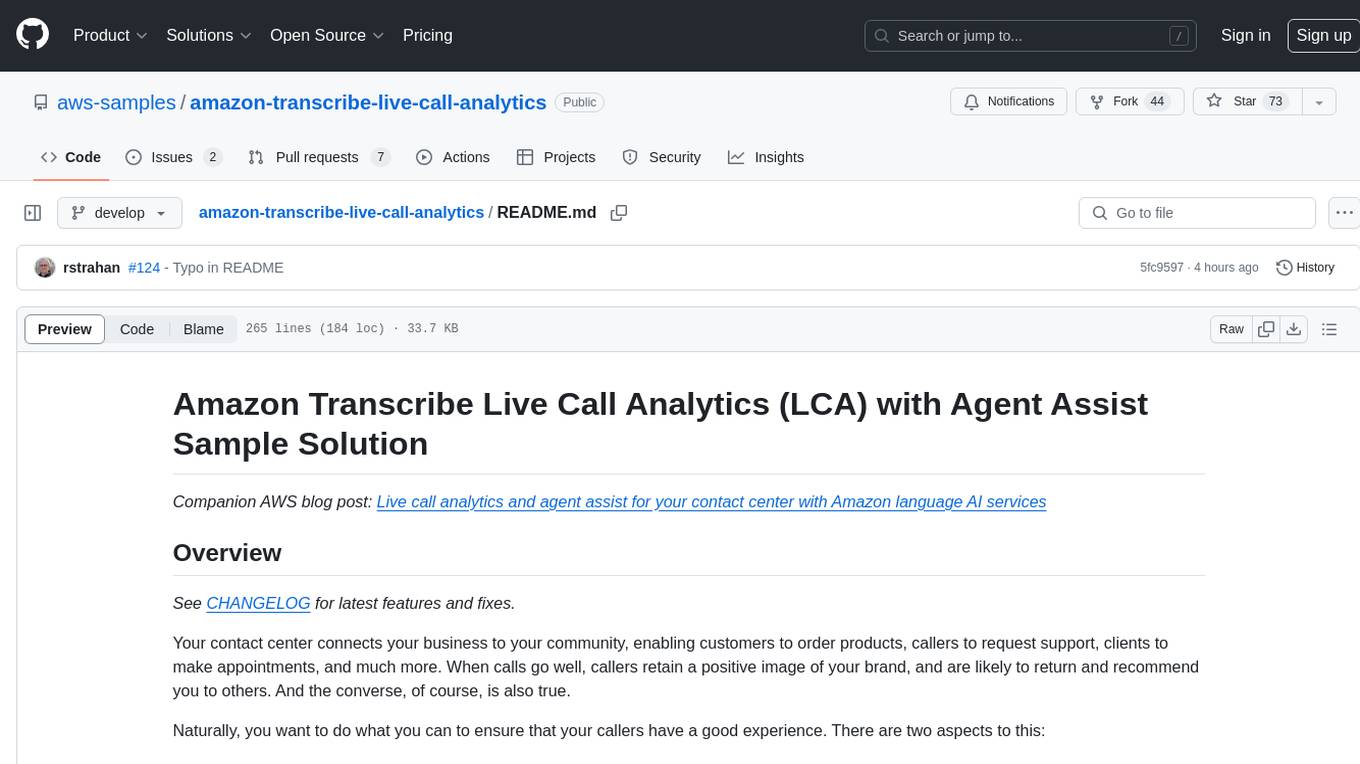
amazon-transcribe-live-call-analytics
The Amazon Transcribe Live Call Analytics (LCA) with Agent Assist Sample Solution is designed to help contact centers assess and optimize caller experiences in real time. It leverages Amazon machine learning services like Amazon Transcribe, Amazon Comprehend, and Amazon SageMaker to transcribe and extract insights from contact center audio. The solution provides real-time supervisor and agent assist features, integrates with existing contact centers, and offers a scalable, cost-effective approach to improve customer interactions. The end-to-end architecture includes features like live call transcription, call summarization, AI-powered agent assistance, and real-time analytics. The solution is event-driven, ensuring low latency and seamless processing flow from ingested speech to live webpage updates.
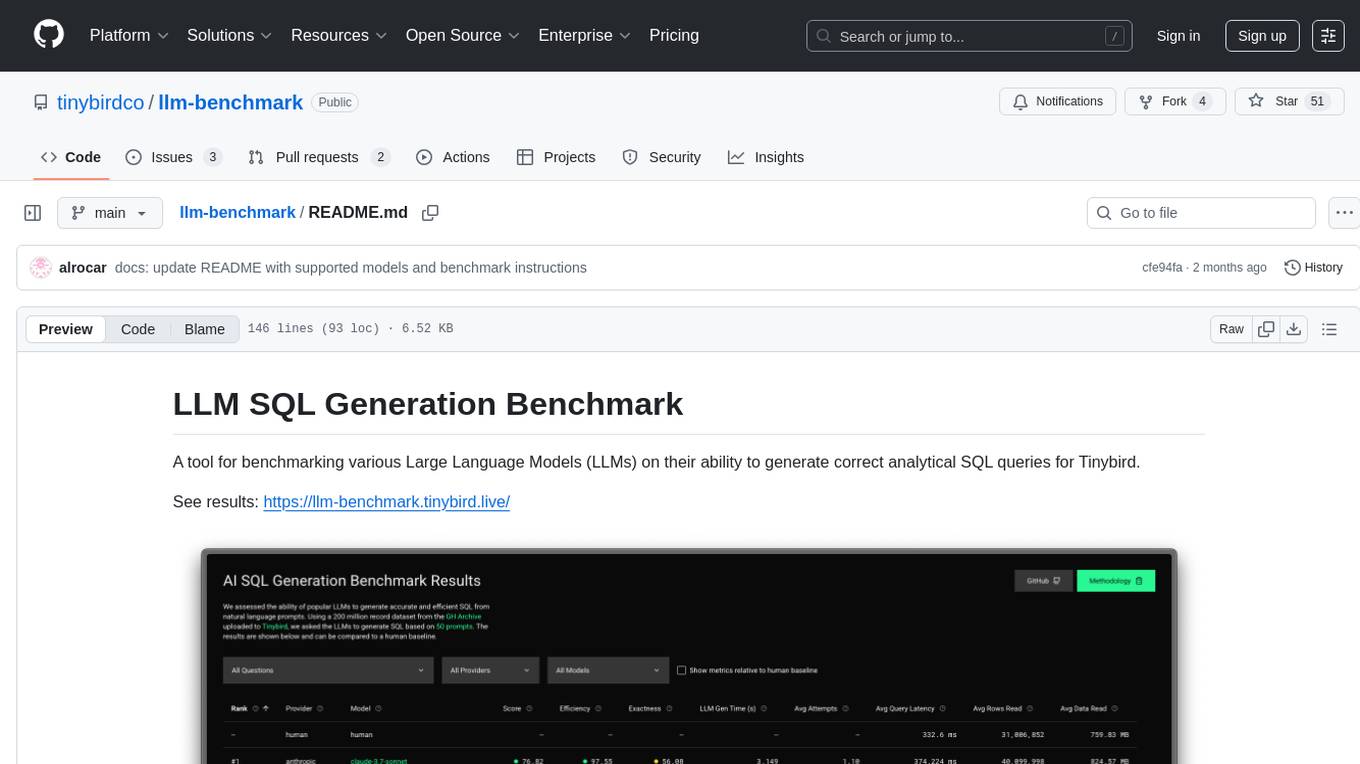
llm-benchmark
LLM SQL Generation Benchmark is a tool for evaluating different Large Language Models (LLMs) on their ability to generate accurate analytical SQL queries for Tinybird. It measures SQL query correctness, execution success, performance metrics, error handling, and recovery. The benchmark includes an automated retry mechanism for error correction. It supports various providers and models through OpenRouter and can be extended to other models. The benchmark is based on a GitHub dataset with 200M rows, where each LLM must produce SQL from 50 natural language prompts. Results are stored in JSON files and presented in a web application. Users can benchmark new models by following provided instructions.
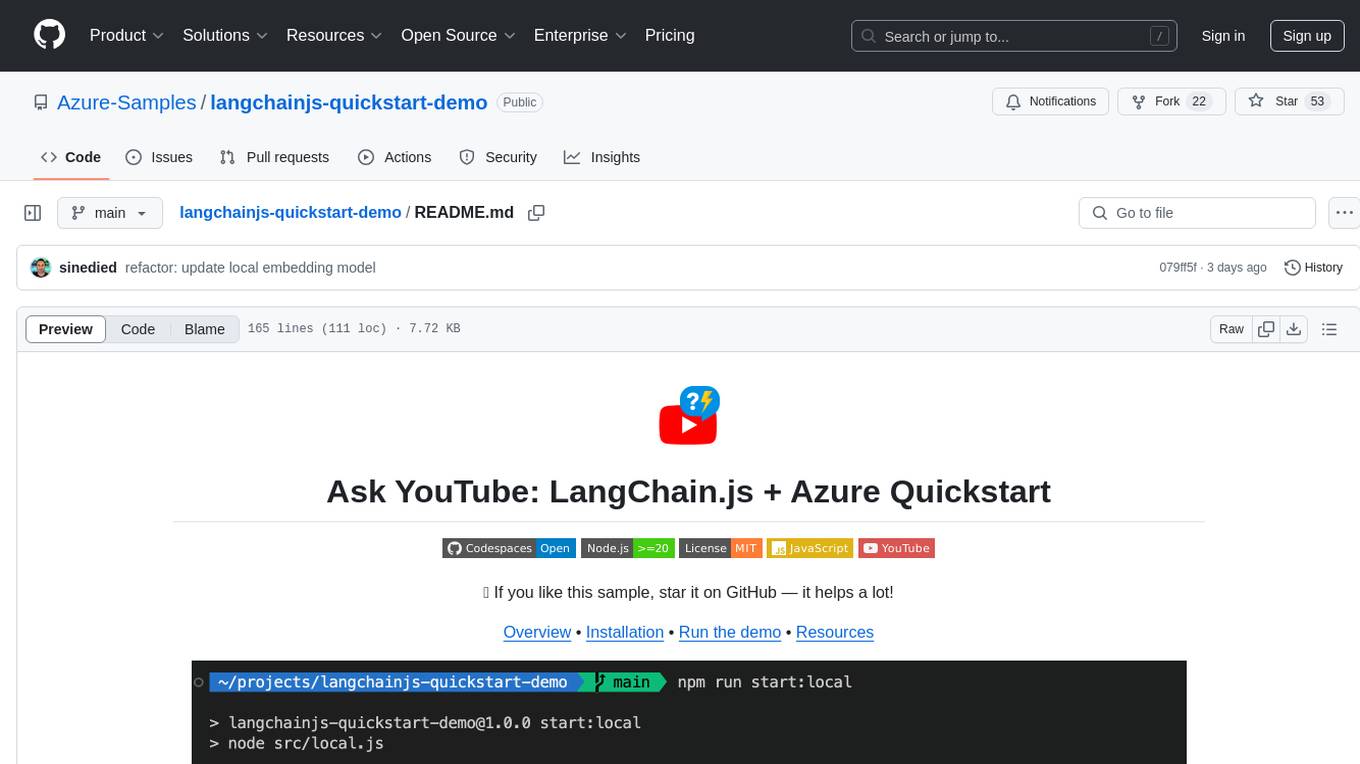
langchainjs-quickstart-demo
Discover the journey of building a generative AI application using LangChain.js and Azure. This demo explores the development process from idea to production, using a RAG-based approach for a Q&A system based on YouTube video transcripts. The application allows to ask text-based questions about a YouTube video and uses the transcript of the video to generate responses. The code comes in two versions: local prototype using FAISS and Ollama with LLaMa3 model for completion and all-minilm-l6-v2 for embeddings, and Azure cloud version using Azure AI Search and GPT-4 Turbo model for completion and text-embedding-3-large for embeddings. Either version can be run as an API using the Azure Functions runtime.

kaito
Kaito is an operator that automates the AI/ML inference model deployment in a Kubernetes cluster. It manages large model files using container images, avoids tuning deployment parameters to fit GPU hardware by providing preset configurations, auto-provisions GPU nodes based on model requirements, and hosts large model images in the public Microsoft Container Registry (MCR) if the license allows. Using Kaito, the workflow of onboarding large AI inference models in Kubernetes is largely simplified.
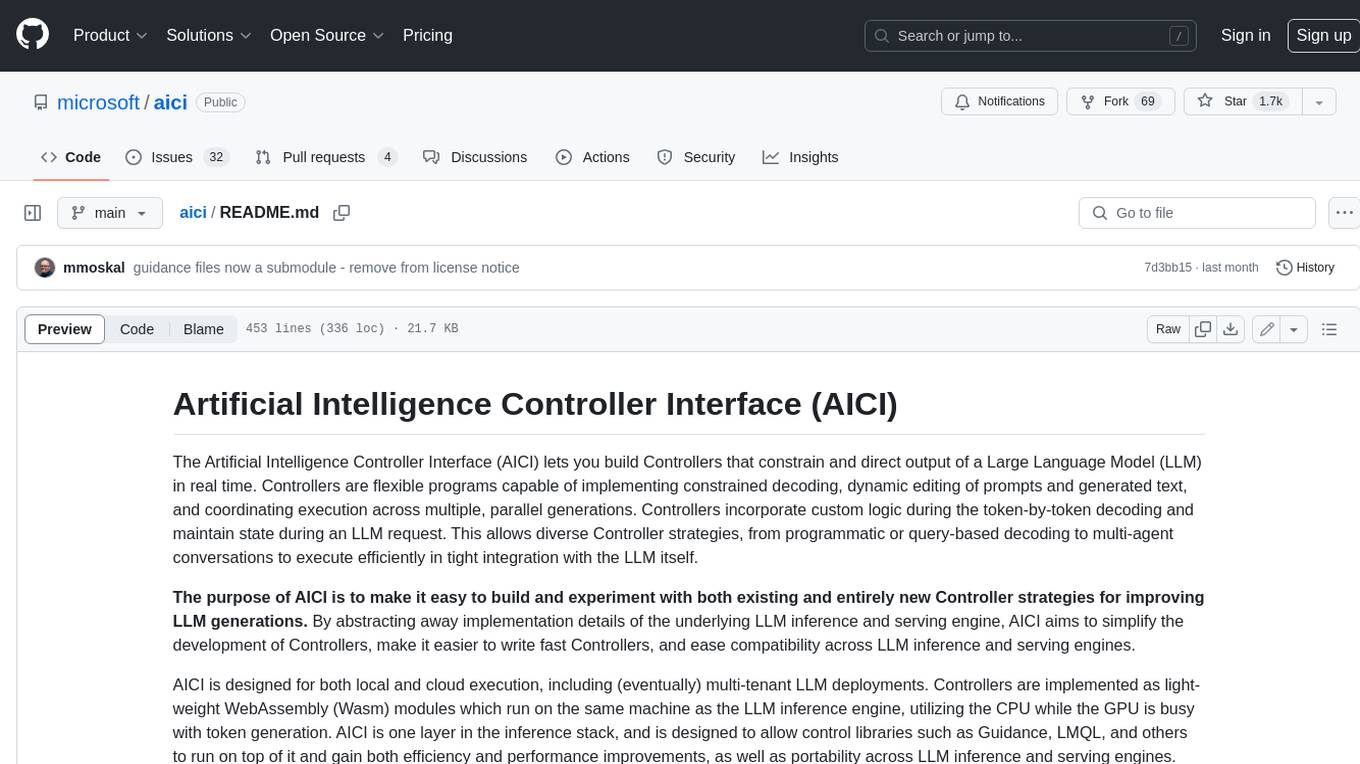
aici
The Artificial Intelligence Controller Interface (AICI) lets you build Controllers that constrain and direct output of a Large Language Model (LLM) in real time. Controllers are flexible programs capable of implementing constrained decoding, dynamic editing of prompts and generated text, and coordinating execution across multiple, parallel generations. Controllers incorporate custom logic during the token-by-token decoding and maintain state during an LLM request. This allows diverse Controller strategies, from programmatic or query-based decoding to multi-agent conversations to execute efficiently in tight integration with the LLM itself.
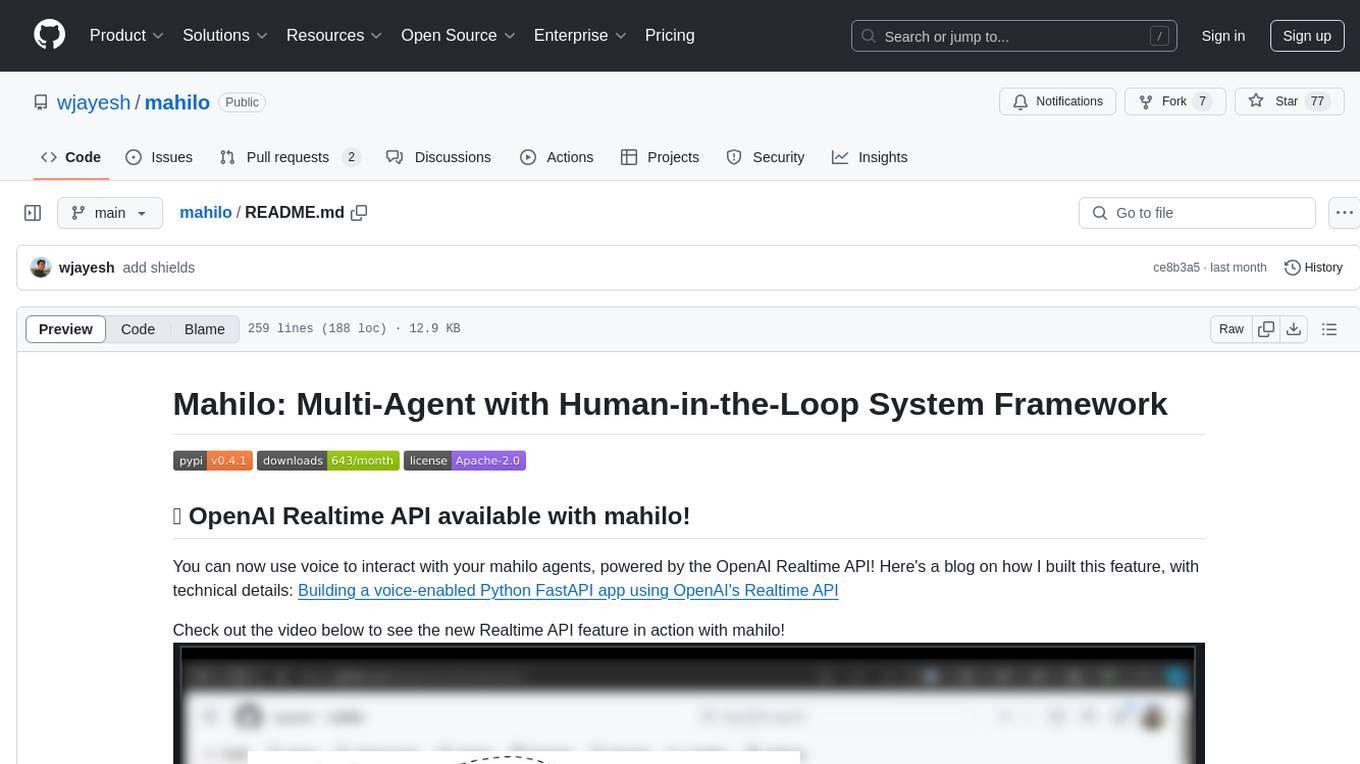
mahilo
Mahilo is a flexible framework for creating multi-agent systems that can interact with humans while sharing context internally. It allows developers to set up complex agent networks for various applications, from customer service to emergency response simulations. Agents can communicate with each other and with humans, making the system efficient by handling context from multiple agents and helping humans stay focused on specific problems. The system supports Realtime API for voice interactions, WebSocket-based communication, flexible communication patterns, session management, and easy agent definition.
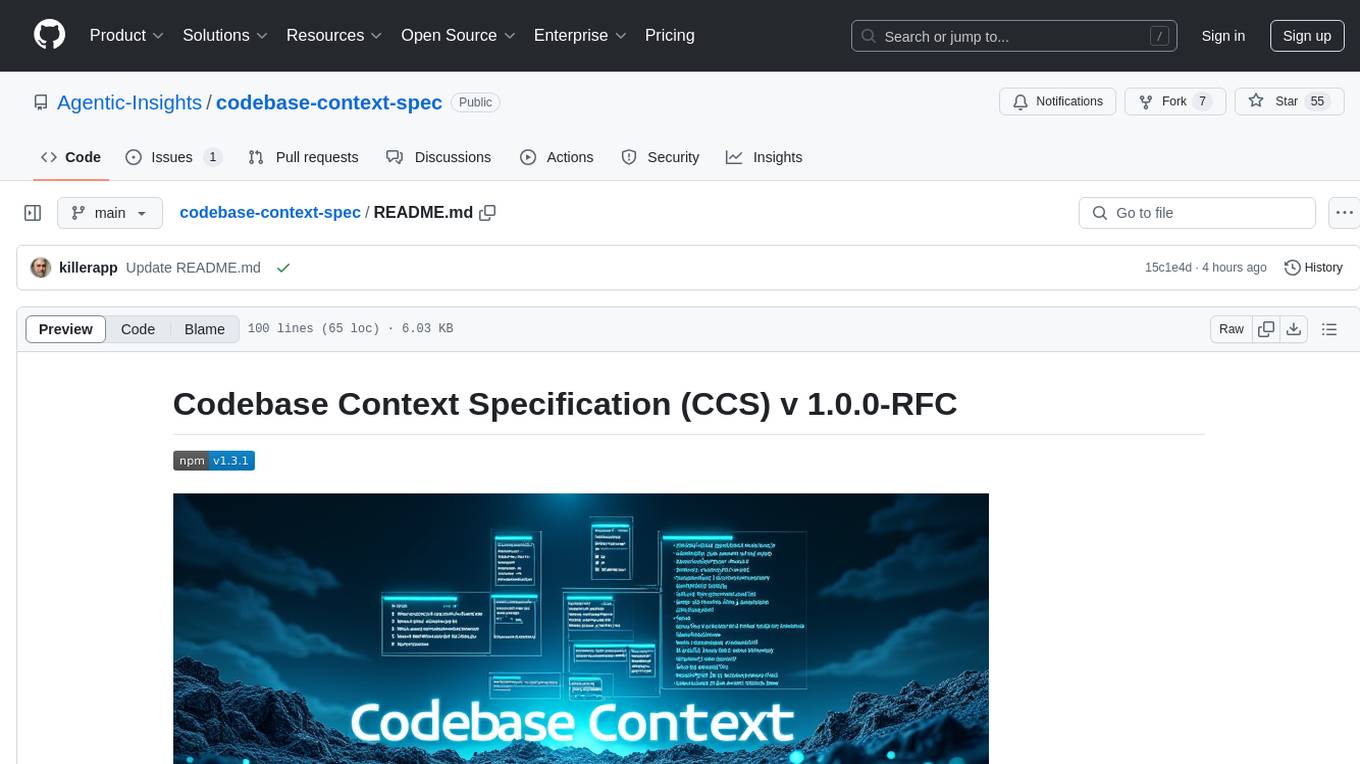
codebase-context-spec
The Codebase Context Specification (CCS) project aims to standardize embedding contextual information within codebases to enhance understanding for both AI and human developers. It introduces a convention similar to `.env` and `.editorconfig` files but focused on documenting code for both AI and humans. By providing structured contextual metadata, collaborative documentation guidelines, and standardized context files, developers can improve code comprehension, collaboration, and development efficiency. The project includes a linter for validating context files and provides guidelines for using the specification with AI assistants. Tooling recommendations suggest creating memory systems, IDE plugins, AI model integrations, and agents for context creation and utilization. Future directions include integration with existing documentation systems, dynamic context generation, and support for explicit context overriding.
For similar tasks

generative-ai-application-builder-on-aws
The Generative AI Application Builder on AWS (GAAB) is a solution that provides a web-based management dashboard for deploying customizable Generative AI (Gen AI) use cases. Users can experiment with and compare different combinations of Large Language Model (LLM) use cases, configure and optimize their use cases, and integrate them into their applications for production. The solution is targeted at novice to experienced users who want to experiment and productionize different Gen AI use cases. It uses LangChain open-source software to configure connections to Large Language Models (LLMs) for various use cases, with the ability to deploy chat use cases that allow querying over users' enterprise data in a chatbot-style User Interface (UI) and support custom end-user implementations through an API.
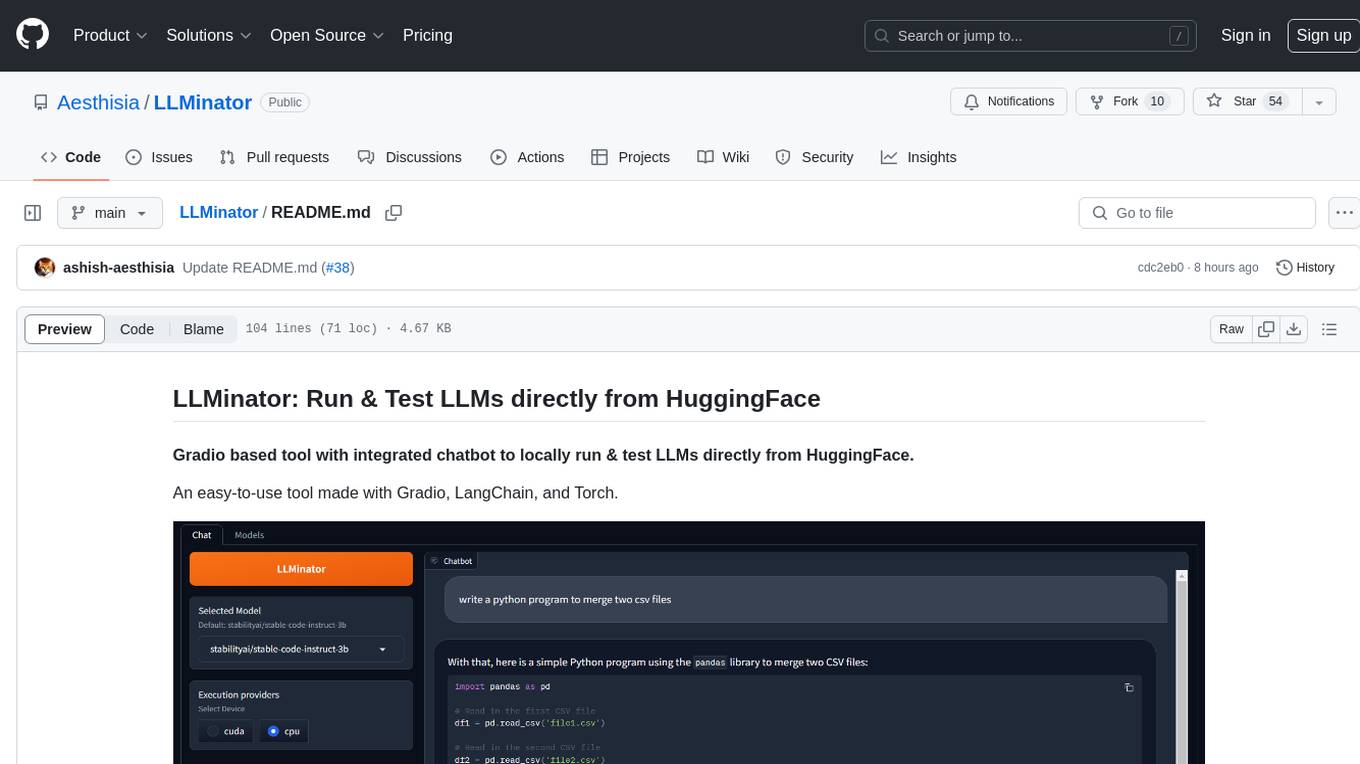
LLMinator
LLMinator is a Gradio-based tool with an integrated chatbot designed to locally run and test Language Model Models (LLMs) directly from HuggingFace. It provides an easy-to-use interface made with Gradio, LangChain, and Torch, offering features such as context-aware streaming chatbot, inbuilt code syntax highlighting, loading any LLM repo from HuggingFace, support for both CPU and CUDA modes, enabling LLM inference with llama.cpp, and model conversion capabilities.
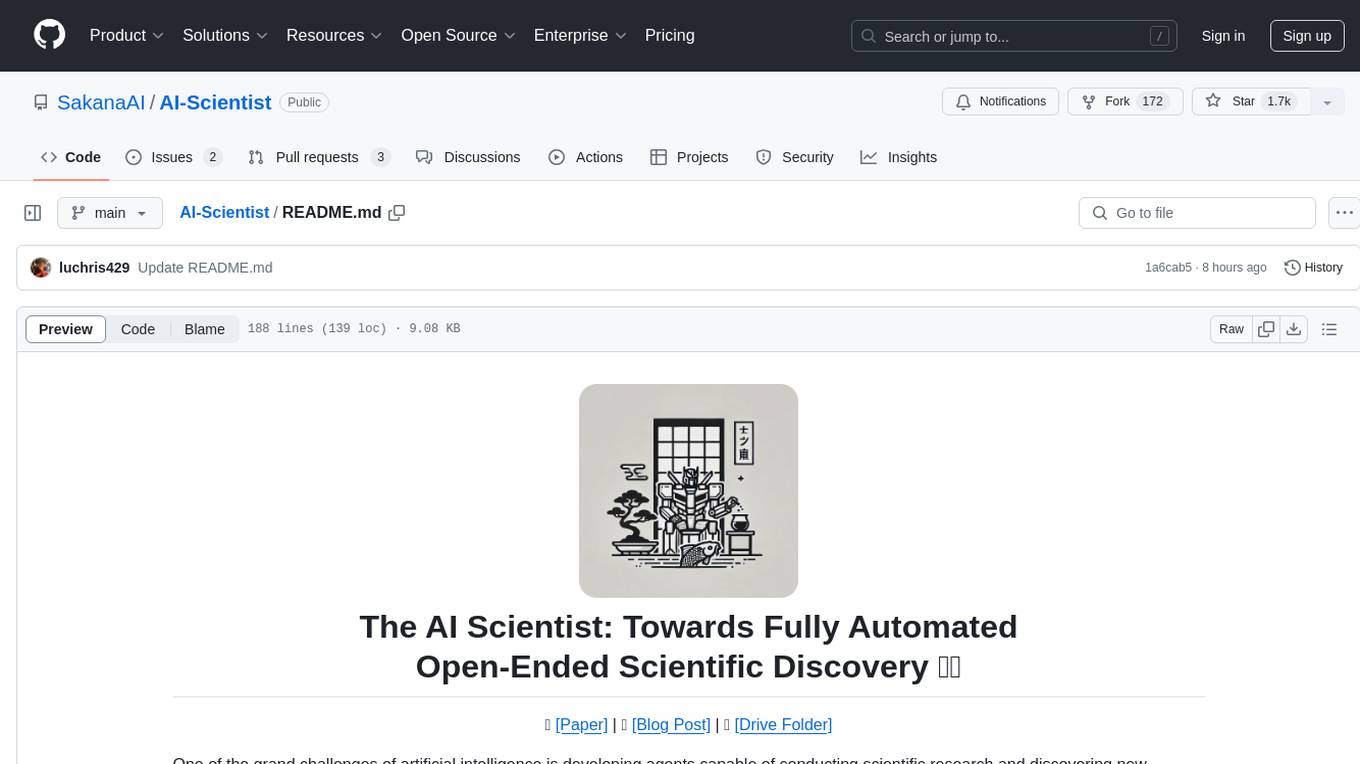
AI-Scientist
The AI Scientist is a comprehensive system for fully automatic scientific discovery, enabling Foundation Models to perform research independently. It aims to tackle the grand challenge of developing agents capable of conducting scientific research and discovering new knowledge. The tool generates papers on various topics using Large Language Models (LLMs) and provides a platform for exploring new research ideas. Users can create their own templates for specific areas of study and run experiments to generate papers. However, caution is advised as the codebase executes LLM-written code, which may pose risks such as the use of potentially dangerous packages and web access.
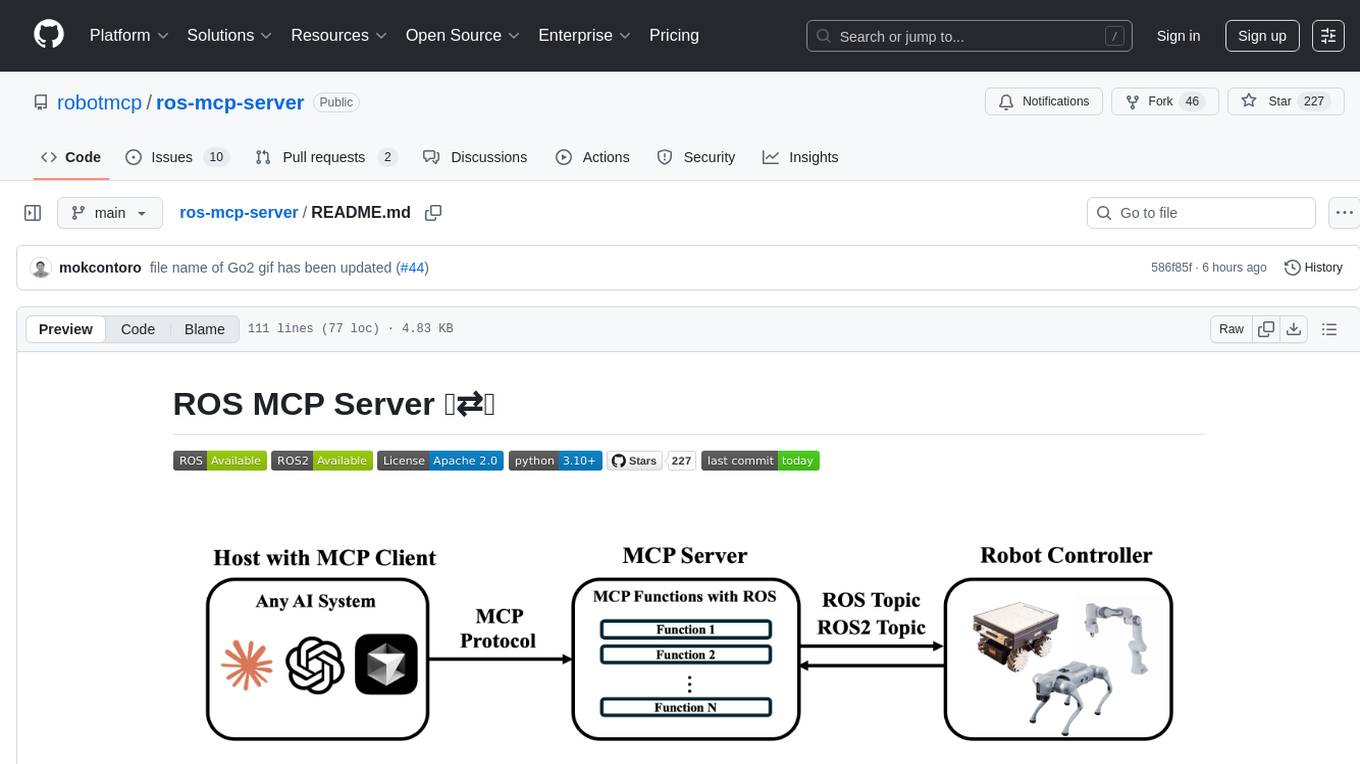
ros-mcp-server
The ros-mcp-server repository contains a ROS (Robot Operating System) package that provides a server for Multi-Contact Planning (MCP) in robotics. The server facilitates the planning of multiple contacts between a robot and its environment, enabling complex manipulation tasks. It includes functionalities for collision checking, motion planning, and contact stability analysis. This tool is designed to enhance the capabilities of robotic systems by enabling them to perform tasks that involve multiple points of contact with the environment. The repository includes documentation and examples to help users integrate the MCP server into their robotic applications.
For similar jobs

sweep
Sweep is an AI junior developer that turns bugs and feature requests into code changes. It automatically handles developer experience improvements like adding type hints and improving test coverage.

teams-ai
The Teams AI Library is a software development kit (SDK) that helps developers create bots that can interact with Teams and Microsoft 365 applications. It is built on top of the Bot Framework SDK and simplifies the process of developing bots that interact with Teams' artificial intelligence capabilities. The SDK is available for JavaScript/TypeScript, .NET, and Python.

ai-guide
This guide is dedicated to Large Language Models (LLMs) that you can run on your home computer. It assumes your PC is a lower-end, non-gaming setup.

classifai
Supercharge WordPress Content Workflows and Engagement with Artificial Intelligence. Tap into leading cloud-based services like OpenAI, Microsoft Azure AI, Google Gemini and IBM Watson to augment your WordPress-powered websites. Publish content faster while improving SEO performance and increasing audience engagement. ClassifAI integrates Artificial Intelligence and Machine Learning technologies to lighten your workload and eliminate tedious tasks, giving you more time to create original content that matters.

chatbot-ui
Chatbot UI is an open-source AI chat app that allows users to create and deploy their own AI chatbots. It is easy to use and can be customized to fit any need. Chatbot UI is perfect for businesses, developers, and anyone who wants to create a chatbot.

BricksLLM
BricksLLM is a cloud native AI gateway written in Go. Currently, it provides native support for OpenAI, Anthropic, Azure OpenAI and vLLM. BricksLLM aims to provide enterprise level infrastructure that can power any LLM production use cases. Here are some use cases for BricksLLM: * Set LLM usage limits for users on different pricing tiers * Track LLM usage on a per user and per organization basis * Block or redact requests containing PIIs * Improve LLM reliability with failovers, retries and caching * Distribute API keys with rate limits and cost limits for internal development/production use cases * Distribute API keys with rate limits and cost limits for students

uAgents
uAgents is a Python library developed by Fetch.ai that allows for the creation of autonomous AI agents. These agents can perform various tasks on a schedule or take action on various events. uAgents are easy to create and manage, and they are connected to a fast-growing network of other uAgents. They are also secure, with cryptographically secured messages and wallets.

griptape
Griptape is a modular Python framework for building AI-powered applications that securely connect to your enterprise data and APIs. It offers developers the ability to maintain control and flexibility at every step. Griptape's core components include Structures (Agents, Pipelines, and Workflows), Tasks, Tools, Memory (Conversation Memory, Task Memory, and Meta Memory), Drivers (Prompt and Embedding Drivers, Vector Store Drivers, Image Generation Drivers, Image Query Drivers, SQL Drivers, Web Scraper Drivers, and Conversation Memory Drivers), Engines (Query Engines, Extraction Engines, Summary Engines, Image Generation Engines, and Image Query Engines), and additional components (Rulesets, Loaders, Artifacts, Chunkers, and Tokenizers). Griptape enables developers to create AI-powered applications with ease and efficiency.

